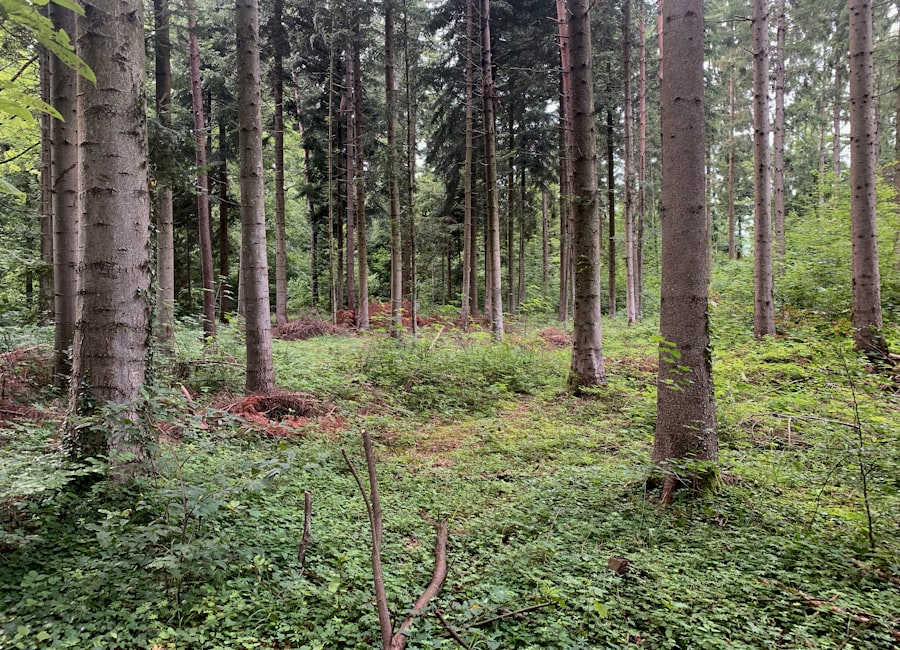Forest therapy, often referred to as “forest bathing,” is a practice that encourages individuals to immerse themselves in nature, promoting a deep connection with the natural world. This therapeutic approach emphasizes the sensory experience of being in a forest environment, allowing participants to engage with their surroundings through sight, sound, smell, and touch. The essence of forest therapy lies in its ability to foster mindfulness and presence, enabling individuals to escape the hustle and bustle of daily life and reconnect with their inner selves.
The practice is not merely about walking through the woods; it involves a deliberate and intentional engagement with nature. Participants are guided to slow down, breathe deeply, and observe the intricate details of their environment. This can include listening to the rustle of leaves, feeling the texture of tree bark, or inhaling the fresh scent of pine.
By cultivating this awareness, forest therapy aims to enhance emotional well-being and promote a sense of peace and tranquility.
Key Takeaways
- Forest therapy, also known as shinrin-yoku, is the practice of immersing oneself in nature to improve overall well-being.
- The concept of forest therapy originated in Japan in the 1980s and has since gained popularity worldwide.
- Forest therapy has been shown to reduce stress, improve mood, boost immune function, and lower blood pressure.
- To practice forest therapy, one can engage in activities such as mindful walking, meditation, and sensory exploration in natural settings.
- Scientific research has demonstrated the positive effects of forest therapy on mental and physical health, making it a valuable tool for stress reduction and overall wellness.
The History of Forest Therapy
Ancient Roots and Indigenous Wisdom
The roots of forest therapy can be traced back to ancient cultures that recognized the healing power of nature. Indigenous peoples around the world have long understood the importance of spending time in natural settings for physical and spiritual well-being.
Modern Revival and Global Interest
In Japan, the practice known as “Shinrin-yoku,” or “forest bathing,” was formally introduced in the 1980s as a public health initiative aimed at reducing stress and improving overall health among citizens. This movement sparked a global interest in the therapeutic benefits of nature. As awareness of mental health issues grew in the late 20th century, researchers began to explore the psychological and physiological effects of spending time in forests.
A Legitimate Form of Treatment
Studies conducted in various countries highlighted the positive impact of nature on mental health, leading to a resurgence of interest in forest therapy as a legitimate form of treatment. Today, forest therapy is recognized not only as a wellness trend but also as an essential component of holistic health practices.
The Benefits of Forest Therapy

The benefits of forest therapy are manifold, encompassing both mental and physical health improvements. One of the most significant advantages is its ability to reduce stress levels. Nature has a calming effect on the mind, and spending time in a forest environment can lower cortisol levels, the hormone associated with stress.
Participants often report feeling more relaxed and centered after engaging in forest therapy sessions. In addition to stress reduction, forest therapy has been linked to enhanced mood and emotional well-being. The act of immersing oneself in nature can lead to increased feelings of happiness and contentment.
Many individuals find that their anxiety diminishes and their overall outlook on life improves after spending time in a forest setting. Furthermore, the social aspect of forest therapy—often practiced in groups—can foster connections among participants, enhancing feelings of belonging and community.
How to Practice Forest Therapy
| Benefits of Forest Therapy | How to Practice Forest Therapy |
|---|---|
| Reduces stress | Find a quiet spot in the forest and sit or walk mindfully |
| Boosts immune system | Engage your senses by observing the sights, sounds, and smells of the forest |
| Improves mood | Practice deep breathing and meditation in a natural setting |
| Enhances creativity | Disconnect from technology and connect with nature |
Practicing forest therapy can be as simple or as structured as one desires. For those new to the concept, it is advisable to start with a guided session led by a trained forest therapy guide. These professionals are equipped with knowledge about the local ecosystem and techniques to facilitate mindfulness in nature.
They often lead participants through a series of activities designed to enhance sensory awareness and promote relaxation. For individuals who prefer a more independent approach, practicing forest therapy can be done by finding a nearby forest or natural area and dedicating time to explore it mindfully. This can involve walking slowly along trails, pausing frequently to observe the surroundings, and engaging in deep breathing exercises.
It is essential to leave behind distractions such as phones or other electronic devices to fully immerse oneself in the experience. Journaling about thoughts and feelings during or after the session can also enhance the therapeutic benefits.
The Science Behind Forest Therapy
The scientific community has increasingly recognized the physiological and psychological benefits of spending time in nature. Research has shown that exposure to natural environments can lead to lower blood pressure, improved immune function, and reduced levels of anxiety and depression. Studies have also indicated that phytoncides—natural compounds released by trees—can enhance immune response and promote overall health.
Neuroscientific research has revealed that being in nature can positively affect brain function. It has been found that natural environments stimulate areas of the brain associated with attention restoration and emotional regulation. This suggests that forest therapy not only provides immediate relief from stress but may also contribute to long-term mental health benefits by fostering resilience against future stressors.
Different Types of Forest Therapy

Forest therapy encompasses various approaches tailored to individual preferences and needs. One popular form is guided forest therapy, where trained facilitators lead participants through structured activities designed to enhance their connection with nature. These sessions often include mindfulness exercises, sensory explorations, and opportunities for reflection.
Another approach is self-guided forest therapy, which allows individuals to explore natural settings at their own pace. This method encourages personal discovery and self-reflection while still reaping the benefits of being in nature. Additionally, some practitioners incorporate elements from other therapeutic modalities, such as art therapy or yoga, into their forest therapy sessions, creating a holistic experience that addresses both mental and physical well-being.
Forest Bathing: A Popular Form of Forest Therapy
Forest bathing has gained significant popularity as a specific form of forest therapy that emphasizes immersion in nature for health benefits. Originating from Japan’s Shinrin-yoku practice, forest bathing encourages individuals to engage all their senses while surrounded by trees and greenery. Participants are guided to slow down their pace, breathe deeply, and fully absorb the sights and sounds around them.
The appeal of forest bathing lies in its simplicity; it does not require any special skills or equipment—just an open mind and a willingness to connect with nature. Many people find that even short sessions of forest bathing can lead to profound feelings of relaxation and rejuvenation. As awareness grows about the importance of mental health, forest bathing has emerged as an accessible way for individuals to prioritize their well-being amidst busy lives.
Forest Therapy and Mental Health
The relationship between forest therapy and mental health is increasingly supported by research highlighting its positive effects on emotional well-being. Numerous studies have shown that spending time in natural environments can alleviate symptoms of anxiety and depression. The calming influence of nature helps individuals gain perspective on their thoughts and feelings, often leading to improved mood and reduced emotional distress.
Moreover, forest therapy provides an opportunity for introspection and self-discovery. Participants often report gaining clarity on personal challenges while surrounded by the tranquility of nature. This reflective aspect can be particularly beneficial for those struggling with mental health issues, as it allows them to process emotions in a supportive environment away from everyday stressors.
Forest Therapy and Physical Health
In addition to its mental health benefits, forest therapy also contributes positively to physical health. Engaging with nature encourages physical activity, whether through walking, hiking, or simply exploring a natural area. Regular physical activity is known to improve cardiovascular health, boost energy levels, and enhance overall fitness.
Furthermore, studies have indicated that spending time in forests can lead to improved immune function due to exposure to phytoncides released by trees. These natural compounds have been shown to increase the activity of natural killer cells in the body, which play a crucial role in fighting off infections and diseases. Thus, forest therapy not only nurtures mental well-being but also supports physical health through its multifaceted approach.
Forest Therapy and Stress Reduction
One of the most significant advantages of forest therapy is its ability to reduce stress effectively. The serene environment of a forest provides a stark contrast to urban life filled with noise and distractions. Research has demonstrated that spending time in nature can lower cortisol levels—often referred to as the “stress hormone”—leading to a more relaxed state.
Participants often find that immersing themselves in nature allows them to disconnect from daily pressures and responsibilities. The act of slowing down and focusing on sensory experiences helps shift attention away from stressors, promoting relaxation and mental clarity. As individuals engage with their surroundings—whether by listening to birdsong or observing the gentle sway of trees—they often experience a profound sense of calm that lingers long after they leave the forest.
Incorporating Forest Therapy into Your Daily Life
Incorporating forest therapy into daily life can be both simple and rewarding. For those living near green spaces or forests, making time for regular visits can significantly enhance overall well-being. Even short walks during lunch breaks or weekend excursions can provide valuable opportunities for connection with nature.
For individuals who may not have immediate access to forests, creating a small green space at home—such as a garden or balcony filled with plants—can also offer therapeutic benefits. Engaging with plants through gardening or simply spending time outdoors can evoke similar feelings of peace and relaxation associated with traditional forest therapy. Additionally, integrating mindfulness practices into daily routines can enhance the effects of forest therapy even when one cannot be physically present in nature.
Techniques such as deep breathing exercises or guided imagery focused on natural settings can help individuals cultivate a sense of calm amidst their busy lives. In conclusion, forest therapy presents a holistic approach to well-being that emphasizes the profound connection between humans and nature. With its rich history, diverse practices, and numerous benefits for mental and physical health, it offers an accessible means for individuals seeking balance in an increasingly hectic world.
By embracing this practice, individuals can unlock the transformative power of nature while nurturing their overall well-being.
FAQs
What is forest therapy?
Forest therapy, also known as forest bathing or shinrin-yoku, is a practice that involves immersing oneself in nature and mindfully experiencing the sights, sounds, and smells of the forest. It is a form of nature therapy that has been shown to have various health benefits.
What are the benefits of forest therapy?
Research has shown that forest therapy can have numerous health benefits, including reduced stress, improved mood, lower blood pressure, increased immune function, and enhanced overall well-being. It has also been linked to improved cognitive function and creativity.
How does forest therapy work?
Forest therapy works by engaging the senses and promoting a state of relaxation and mindfulness. By immersing oneself in nature and focusing on the present moment, individuals can experience a sense of calm and connection with the natural world, which can have positive effects on both physical and mental health.
What activities are involved in forest therapy?
Forest therapy activities can include walking or sitting in nature, mindful breathing exercises, guided meditation, and sensory awareness practices. The goal is to engage with the natural environment in a way that promotes relaxation and mindfulness.
Is forest therapy the same as hiking or camping?
While forest therapy may involve walking in the forest, it is different from traditional hiking or camping in that the focus is on mindfulness and sensory engagement rather than physical exertion or outdoor recreation. Forest therapy is more about slowing down and immersing oneself in nature, rather than covering long distances or engaging in strenuous activities.









